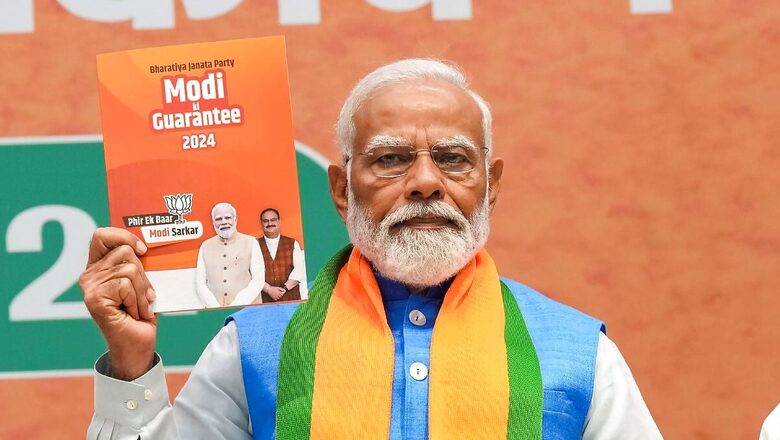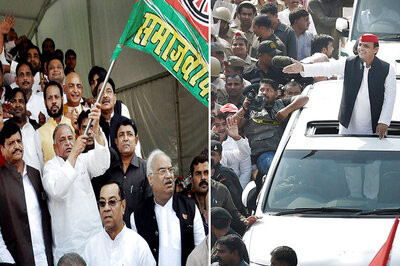
views
Of the several transformative changes that PM Modi has unleashed in the last 10 years, an important one is a paradigm change in the way a political manifesto is viewed now. Titled ‘Modi Ki Guarantee’, BJP’s 2024 manifesto is perhaps the most ambitious the country has ever seen. Unencumbered by short-term political calculations, the manifesto talks big and sets a roadmap for the nation and national discourse for the next two decades. It is a blueprint for taking India through the upward curve of becoming Viksit Bharat, a developed nation.
The Big Ideas
First and foremost, the extension of Ayushman Bharat cover to all citizens above 70 years is a landmark step. This brings a huge relief not just to the 17 per cent population that is above 70 years of age but also to their children who are invariably impacted by their parents’ illnesses.
On the more ambitious side, the mission statement to achieve energy independence by 2047 is nothing short of revolutionary. The increased impetus to the innovative PM Surya Ghar Muft Bijli Yojana where poor households become the producers and traders of electricity is a refreshing game-changer from the freebie politics of other parties.
Expansion of India’s piped gas network, creation of a homegrown shipping industry, expansion of the water metro, and implementation of next-generation “land record digitalisation” are some of the other positive agendas of the manifesto.
The manifesto talks about making India a global manufacturing hub and emphasises upon the manufacturing of “high value” products, particularly the defence sector and railway manufacturing. It promises continued aggression on the infrastructure development plan with a vision for three new bullet trains, one in each region. It equally emphasises upon women’s empowerment and spells out the commitment to creating 3 crore Lakhpati Didis, and 3 crore more homes under PM Awas Yojana, besides increasing the Mudra loan limit to Rs 20 lakh.
Having mentioned these, the biggest ideas are of course Uniform Civil Code (UCC) and ‘One Nation, One Poll’, which have the potential to alter the country’s political discourse significantly.
Global Initiatives
The global outreach section in the manifesto is again extremely aspirational and progressive. It talks about expanding India’s Digital Public Infrastructure (DPI) across the world, safeguarding India’s digital sovereignty, taking yoga global, besides championing the cause of the Global South. Significantly, the manifesto talks about spreading the legacy of Lord Ram globally and creating Ramayana festivals across the world. For those who shied away from attending the Pran Pratishtha of Ram Mandir, this must have come as a shock. The manifesto equally emphasises that India will build global consensus against terrorism while pursuing global alliances for the larger good.
Northeast Outreach
Considering that the transformation of our Northeastern states has been one of the key achievements of the Modi government in the last 10 years, some big announcements were expected here and rightly so.
The manifesto talks about leveraging Northeast as a strategic gateway for the Act East Policy, ensuring connectivity, education, health, economic development and security. It pledges to build ‘sarovars’ to manage floods in the Northeast that will ensure flood management by conducting advanced satellite imagery to identify places where big reservoirs can be constructed to store excess water according to topography, which will be used for irrigation, organising water sports among others. It talks about formulating the Purvodaya Master Plan for targeted and integrated infrastructure development of eastern India.
A tale of two manifestos
While the BJP manifesto is an unequivocally progressive document, as one reads through the details, one can’t help feeling how the Congress manifesto comes across as a regressive, orthodox piece of literature in comparison. The two manifestos also explain the ever-widening support base of the two parties. While the BJP manifesto emphasises its zero tolerance towards terrorism, the Congress manifesto indicates its intent to go soft on terrorism.
The Congress, in one of its promises, has stated that the intelligence agencies will be brought under the Parliament or relevant state governments. This not only complicates the problem of oversight, but could disrupt the working of critical organisations engaged in the internal security of the country. More pressure from the government (Centre or state) or panels appointed by any government (state and Centre) on the law enforcement agencies also creates operational hurdles.
While the BJP manifesto talks about championing India’s cultural outreach globally, the Congress party cannot get itself to think beyond ‘preserving’ personal laws. While the BJP manifesto is futuristic and empowering, the Congress manifesto can’t rise above freebies. While the BJP manifesto is brimming with confidence and stays away from any reference to caste or creed or minority, the Congress manifesto has gone overboard with its divisive agenda, going so far as condemning majoritarianism and promising scholarships for minorities to study abroad.
While the BJP manifesto repeatedly emphasises its pledge to make India a global manufacturing hub with a special focus on defence, railways and high-value products, the Congress manifesto has claimed that policy preference will be given to those businesses that create a greater number of jobs. Put simply, they are incentivizing the creation of sweatshops (cheap labour-driven industries manufacturing high-volume, low-value products) over strategic industries, like semiconductors. This not only hurts India’s long-term strategic interests in the global supply chain context, but also hinders the manufacturing ecosystem from evolving.
The Congress also brazenly extends its divisive agenda to the judiciary. They have stated that the appointment of judges will be linked to the communities they come from. This is not only inconsistent with principles of merit, but also creates a window for lobbying in the high courts.
A careful look at both manifestos explains why people of the country trust PM Modi and the BJP implicitly. The Congress manifesto, on the other hand, reflects a fringe thought process.
The writer is a well-known author and national spokesperson of BJP. Views expressed in the above piece are personal and solely those of the author. They do not necessarily reflect News18’s views.



















Comments
0 comment